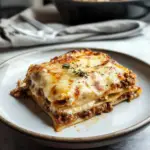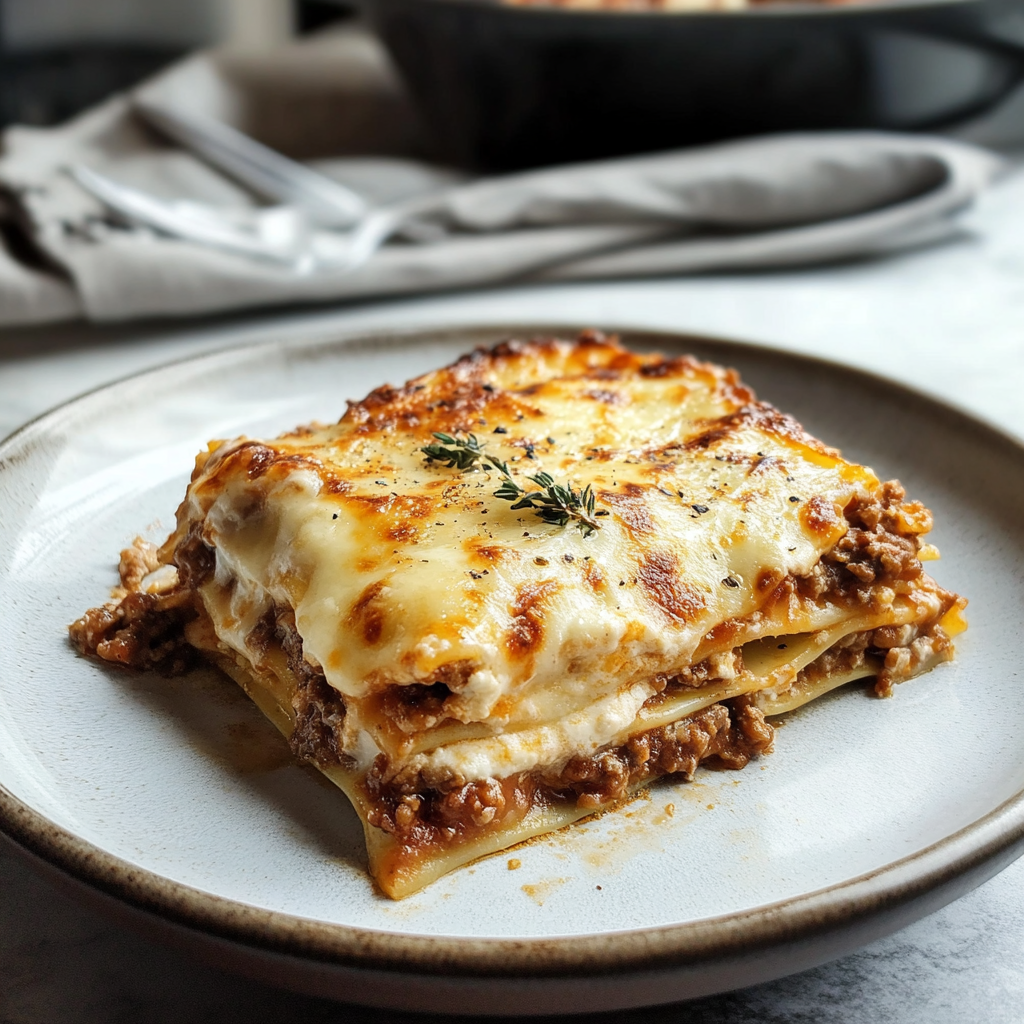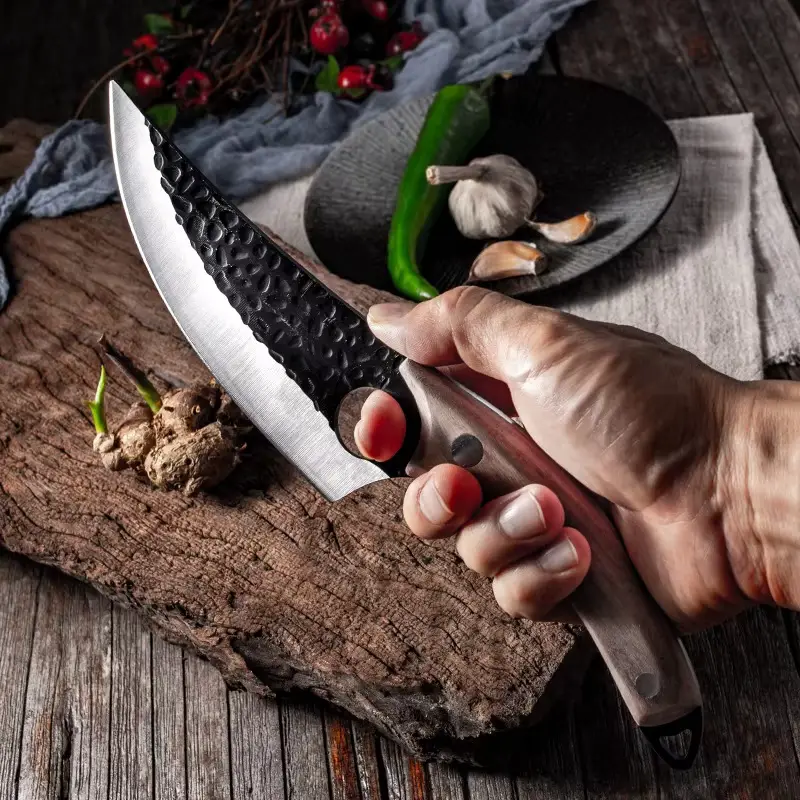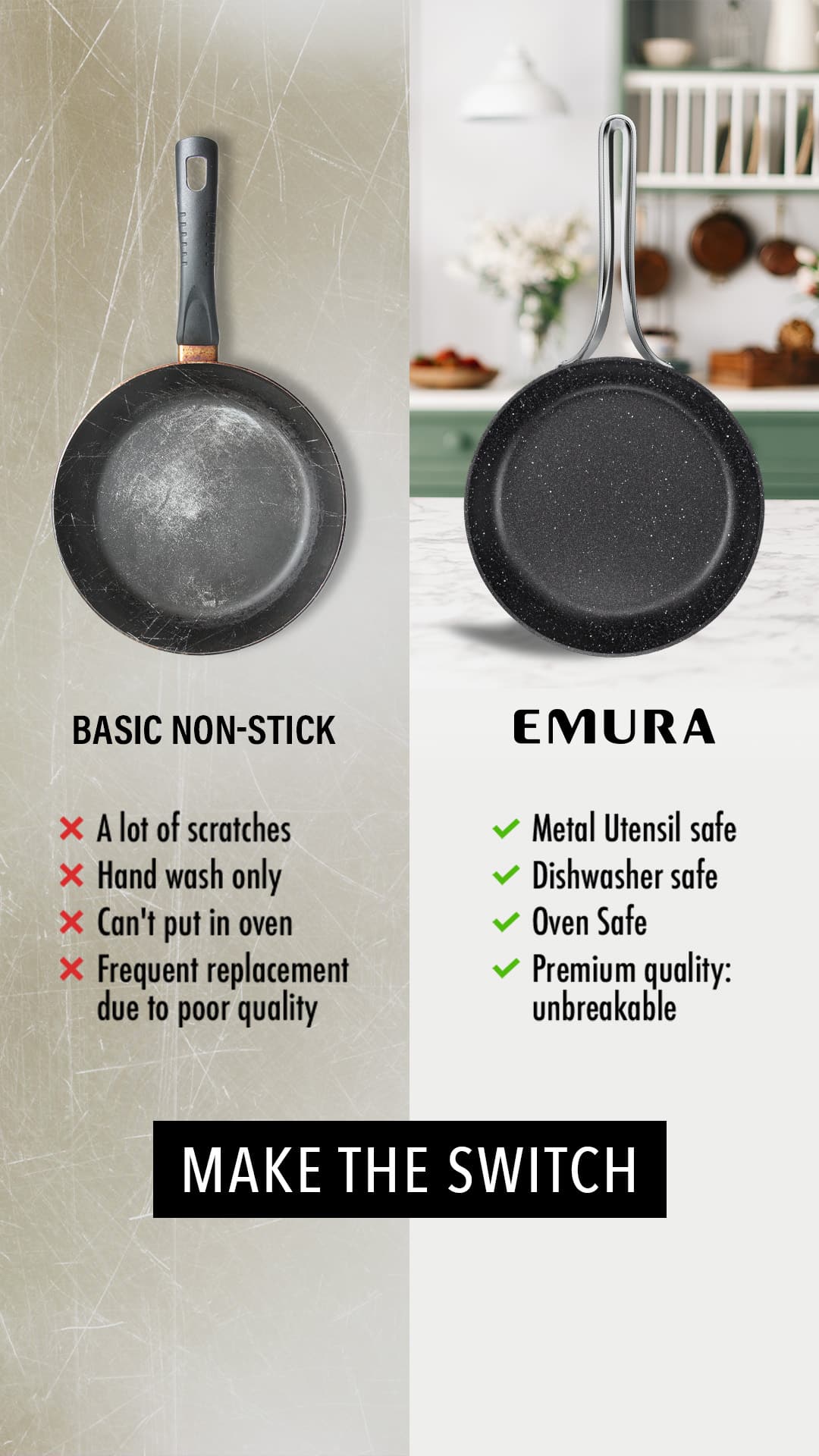If you’re looking to bring the taste of Tuscany into your kitchen, this Classic Tuscan Lasagna with Ragù and Béchamel is a must-try. Unlike the American-style lasagna layered with ricotta, Tuscan lasagna is rich, creamy, and deeply savory, featuring layers of slow-cooked meat sauce (ragù), silky béchamel sauce, and perfectly cooked pasta sheets. This traditional Italian recipe takes time to prepare but rewards you with a deeply flavorful dish that’s perfect for gatherings, holidays, or cozy family dinners.
The key to an authentic Tuscan lasagna lies in two classic Italian sauces: the hearty ragù, made with ground meat, tomatoes, and red wine, and a luxurious béchamel, a creamy sauce made from butter, flour, and milk. These sauces come together with layers of pasta sheets and a light sprinkling of Parmesan cheese, creating a lasagna that’s balanced, comforting, and packed with flavor. Unlike American lasagna, which often relies on a thicker cheese layer, this version is more delicate, allowing each ingredient to shine.
In this recipe, you’ll learn how to make each component from scratch, bringing the authentic flavors of Italy to your table. From the rich, slow-simmered ragù to the creamy béchamel, every step is designed to create a dish that’s worthy of a special occasion or a memorable Sunday dinner.
Why You’ll Love This Recipe
Classic Tuscan Lasagna is the epitome of comfort food, with layers of flavors that meld beautifully together. You’ll love the hearty and savory ragù, which is balanced by the creamy, delicate béchamel. This lasagna is incredibly satisfying but not overly heavy, making it a perfect dish to serve at gatherings or family dinners. The recipe uses simple ingredients but involves a few steps that ensure a deep, rich flavor. This lasagna is ideal for making ahead, allowing the flavors to develop even more before serving. Plus, baking it in the oven creates a beautiful golden crust on top that’s impossible to resist.
Preparation Time and Servings
- Prep Time: 45 minutes
- Cook Time: 2.5 hours (including simmering time for ragù)
- Total Time: 3 hours 15 minutes
- Yield: 8 servings
- Serving Size: 1 slice
Nutritional Information (per serving)
- Calories: 420 kcal
- Carbohydrates: 35g
- Protein: 20g
- Fat: 22g
- Fiber: 3g
- Sugar: 5g
Ingredients
For the Ragù (Meat Sauce)
- 2 tablespoons olive oil
- 1 medium onion, finely chopped
- 1 medium carrot, finely chopped
- 1 celery stalk, finely chopped
- 2 cloves garlic, minced
- 1 pound ground beef (or a mix of beef and pork)
- 1/2 cup red wine
- 1 can (28 ounces) crushed tomatoes
- 1/4 cup tomato paste
- 1/2 cup beef broth
- 1 teaspoon dried thyme
- 1 teaspoon dried oregano
- 1 bay leaf
- Salt and black pepper to taste
For the Béchamel Sauce
- 1/4 cup unsalted butter
- 1/4 cup all-purpose flour
- 2 cups whole milk, warmed
- 1/4 teaspoon ground nutmeg
- Salt and white pepper to taste
For the Lasagna Assembly
- 12 lasagna noodles (preferably fresh, or no-boil if using dry pasta)
- 1 cup freshly grated Parmesan cheese
- Fresh basil or parsley for garnish (optional)
Step-by-Step Instructions
Step 1: Prepare the Ragù (Meat Sauce)
- Sauté the Vegetables: In a large pot or Dutch oven, heat the olive oil over medium heat. Add the finely chopped onion, carrot, and celery, cooking until softened, about 5-7 minutes. This combination of vegetables, known as soffritto, forms the base of the ragù, adding depth of flavor.
- Add Garlic and Meat: Stir in the minced garlic and cook for an additional minute until fragrant. Add the ground meat, breaking it up with a wooden spoon. Cook until the meat is browned, about 5 minutes.
- Deglaze with Wine: Pour in the red wine, scraping any browned bits from the bottom of the pot. Allow the wine to reduce for a few minutes until most of the liquid has evaporated.
- Add Tomatoes and Seasoning: Stir in the crushed tomatoes, tomato paste, beef broth, dried thyme, oregano, bay leaf, and a pinch of salt and pepper.
- Simmer the Ragù: Reduce the heat to low, cover, and let the sauce simmer gently for 1.5 to 2 hours, stirring occasionally. The sauce should become thick and flavorful. Adjust seasoning with salt and pepper as needed, and remove the bay leaf before using the sauce in the lasagna.
Step 2: Prepare the Béchamel Sauce
- Melt Butter: In a medium saucepan, melt the butter over medium heat.
- Add Flour: Whisk in the flour, stirring constantly to form a roux. Cook for about 2 minutes, until the roux is golden and has a nutty aroma.
- Add Milk Gradually: Slowly pour in the warmed milk, whisking continuously to prevent lumps. Keep whisking until the sauce thickens, about 5 minutes.
- Season the Béchamel: Add the ground nutmeg, and season with salt and white pepper to taste. The béchamel should be smooth and creamy, with a mild flavor that complements the ragù.
Step 3: Cook the Lasagna Noodles (if using fresh or regular noodles)
- Boil the Noodles: If you’re using fresh or regular lasagna noodles, cook them in salted boiling water according to package instructions until al dente. Drain and rinse under cold water to prevent sticking.
- Lay Out to Dry: Place the noodles in a single layer on a baking sheet, brushing lightly with olive oil to keep them from sticking.
Step 4: Assemble the Lasagna
- Preheat Oven: Preheat your oven to 375°F (190°C).
- Layer the Ingredients: Spread a thin layer of ragù on the bottom of a 9×13-inch baking dish. Place a layer of noodles over the sauce, followed by more ragù, a thin layer of béchamel, and a sprinkle of Parmesan cheese. Repeat the layers, ending with a layer of noodles topped with béchamel and a generous sprinkle of Parmesan.
- Finish with Parmesan: On the final layer, spread the remaining béchamel and sprinkle with a generous amount of Parmesan cheese. This will create a beautifully golden crust when baked.
Step 5: Bake the Lasagna
- Cover and Bake: Cover the lasagna with aluminum foil and bake in the preheated oven for 25 minutes.
- Uncover and Continue Baking: Remove the foil and bake for an additional 15-20 minutes, or until the top is golden and bubbling.
- Let Rest: Remove the lasagna from the oven and let it rest for 10-15 minutes before slicing. This helps the layers set and makes it easier to cut clean slices.
Step 6: Garnish and Serve
- Garnish: If desired, sprinkle fresh basil or parsley over the top for added color and flavor.
- Serve: Slice the lasagna and serve warm. Pair with a side salad or garlic bread for a complete Italian-inspired meal.
Ingredient Background
Ragù is a classic Italian meat sauce that’s hearty, flavorful, and slow-cooked for depth. It typically includes ground meat, tomatoes, and a combination of aromatics and herbs. Béchamel sauce is one of the “mother sauces” in French and Italian cuisine, made with butter, flour, and milk. Its creamy texture adds richness to the lasagna without overwhelming the other flavors. Parmesan cheese adds a savory, umami-rich note that enhances both the béchamel and ragù, bringing the dish together.
Technique Tips
- Use Quality Ingredients: Since this dish has few components, using high-quality ingredients, such as good Parmesan cheese and fresh pasta if possible, makes a noticeable difference.
- Simmer the Ragù Low and Slow: The longer the ragù simmers, the richer the flavor will be. Don’t rush this step.
- Don’t Overdo the Béchamel: Béchamel should be spread in thin layers to add creaminess without overpowering the other ingredients.
- Rest Before Slicing: Letting the lasagna rest after baking ensures it holds its shape when sliced and helps the flavors meld together.
Alternative Presentation Ideas
- Individual Portions: Use ramekins or mini baking dishes to make individual servings of lasagna for an elegant presentation.
- Layered Lasagna Roll-Ups: Roll each noodle with ragù and béchamel to create lasagna roll-ups, which are great for serving in single portions.
- Vegetarian Tuscan Lasagna: Substitute the ragù with a vegetable filling, such as mushrooms, spinach, and zucchini, for a vegetarian version.
Additional Tips for Success
- Use Fresh Pasta Sheets If Possible: Fresh pasta sheets cook more evenly and absorb the flavors of the sauces better.
- Season Each Layer: Lightly season each layer of the lasagna to ensure every bite is flavorful.
- Cover with Foil to Prevent Drying: Covering the lasagna with foil for the first part of baking helps prevent the top from drying out.
Recipe Variations
- Mushroom Ragù Lasagna: Replace the meat in the ragù with a mixture of mushrooms for a hearty, vegetarian version.
- Four-Cheese Lasagna: Add layers of ricotta, mozzarella, and fontina cheese along with Parmesan for a richer, cheesier version.
- Spinach and Ricotta Lasagna: Add a layer of spinach and ricotta to the lasagna for a slightly lighter, vegetarian twist.
Freezing and Storage
- Storing Leftovers: Store leftover lasagna in an airtight container in the refrigerator for up to 3 days. Reheat in the oven to maintain texture.
- Freezing: You can freeze lasagna for up to 3 months. Wrap it tightly with plastic wrap and aluminum foil before freezing. Thaw overnight in the refrigerator and bake until heated through.
- Reheating: To reheat, cover the lasagna with foil and bake at 350°F (175°C) until warmed through.
Healthier Twist Ideas
- Use Whole Wheat Pasta: Substitute whole wheat lasagna noodles for added fiber.
- Reduce Cheese: Use less Parmesan or a lighter cheese to reduce fat content.
- Add Vegetables: Include layers of thinly sliced zucchini or eggplant to add nutrients and texture.
Serving Suggestions for Events
- Family Gatherings: This dish is perfect for family gatherings, as it can be prepared in advance and serves a crowd.
- Holiday Celebrations: Serve Classic Tuscan Lasagna for Christmas or Easter as a hearty, comforting main course.
- Dinner Parties: Present individual lasagna servings for a more elegant approach to serving lasagna at dinner parties.
Special Equipment
- Dutch Oven: Ideal for simmering the ragù, as it retains heat evenly and prevents scorching.
- 9×13-Inch Baking Dish: A standard baking dish that’s perfect for assembling and baking lasagna.
- Whisk: A whisk is essential for creating a smooth béchamel sauce.
Frequently Asked Questions
1. Can I use store-bought lasagna noodles?
Yes, store-bought no-boil noodles are convenient and work well in this recipe. Be sure to add extra sauce, as they absorb more liquid.
2. How do I prevent my lasagna from being watery?
Make sure to simmer the ragù until thick and cook the béchamel to the right consistency. Letting the lasagna rest after baking also helps it set.
3. Can I make this lasagna gluten-free?
Yes, use gluten-free lasagna noodles and gluten-free flour for the béchamel.
4. Can I make the sauces ahead of time?
Absolutely! Both the ragù and béchamel can be made up to 2 days in advance and stored in the refrigerator.
5. What’s the difference between Tuscan lasagna and regular lasagna?
Tuscan lasagna traditionally uses a ragù and béchamel instead of ricotta, creating a more delicate texture and balanced flavor.
6. Can I freeze assembled lasagna before baking?
Yes, you can assemble the lasagna, freeze it, and bake it directly from frozen. Just add extra baking time.
7. Can I add other cheeses?
Certainly! While Parmesan is traditional, mozzarella and fontina also add a delicious creamy texture.
8. How do I prevent the top from burning?
Cover with foil for the first part of baking, then remove it to allow browning without burning.
Conclusion
Classic Tuscan Lasagna with Ragù and Béchamel is a comforting, savory dish that’s perfect for any special occasion or family meal. With layers of slow-simmered meat sauce, creamy béchamel, and tender pasta, each bite offers a balance of flavors that is rich yet harmonious. This lasagna is ideal for making ahead, and its leftovers are even more flavorful the next day. Whether you’re cooking for a holiday, a gathering, or a Sunday dinner, this Tuscan lasagna will bring warmth and satisfaction to your table. Enjoy the rich, comforting taste of Tuscany in every bite!
Print
Classic Tuscan Lasagna with Ragù and Béchamel
- Total Time: 3 hours 15 minutes
- Yield: 8 servings 1x
Ingredients
For the Ragù (Meat Sauce)
- 2 tablespoons olive oil
- 1 medium onion, finely chopped
- 1 medium carrot, finely chopped
- 1 celery stalk, finely chopped
- 2 cloves garlic, minced
- 1 pound ground beef (or a mix of beef and pork)
- 1/2 cup red wine
- 1 can (28 ounces) crushed tomatoes
- 1/4 cup tomato paste
- 1/2 cup beef broth
- 1 teaspoon dried thyme
- 1 teaspoon dried oregano
- 1 bay leaf
- Salt and black pepper to taste
For the Béchamel Sauce
- 1/4 cup unsalted butter
- 1/4 cup all-purpose flour
- 2 cups whole milk, warmed
- 1/4 teaspoon ground nutmeg
- Salt and white pepper to taste
For the Lasagna Assembly
- 12 lasagna noodles (preferably fresh, or no-boil if using dry pasta)
- 1 cup freshly grated Parmesan cheese
- Fresh basil or parsley for garnish (optional)
Instructions
Step 1: Prepare the Ragù (Meat Sauce)
- Sauté the Vegetables: In a large pot or Dutch oven, heat the olive oil over medium heat. Add the finely chopped onion, carrot, and celery, cooking until softened, about 5-7 minutes. This combination of vegetables, known as soffritto, forms the base of the ragù, adding depth of flavor.
- Add Garlic and Meat: Stir in the minced garlic and cook for an additional minute until fragrant. Add the ground meat, breaking it up with a wooden spoon. Cook until the meat is browned, about 5 minutes.
- Deglaze with Wine: Pour in the red wine, scraping any browned bits from the bottom of the pot. Allow the wine to reduce for a few minutes until most of the liquid has evaporated.
- Add Tomatoes and Seasoning: Stir in the crushed tomatoes, tomato paste, beef broth, dried thyme, oregano, bay leaf, and a pinch of salt and pepper.
- Simmer the Ragù: Reduce the heat to low, cover, and let the sauce simmer gently for 1.5 to 2 hours, stirring occasionally. The sauce should become thick and flavorful. Adjust seasoning with salt and pepper as needed, and remove the bay leaf before using the sauce in the lasagna.
Step 2: Prepare the Béchamel Sauce
- Melt Butter: In a medium saucepan, melt the butter over medium heat.
- Add Flour: Whisk in the flour, stirring constantly to form a roux. Cook for about 2 minutes, until the roux is golden and has a nutty aroma.
- Add Milk Gradually: Slowly pour in the warmed milk, whisking continuously to prevent lumps. Keep whisking until the sauce thickens, about 5 minutes.
- Season the Béchamel: Add the ground nutmeg, and season with salt and white pepper to taste. The béchamel should be smooth and creamy, with a mild flavor that complements the ragù.
Step 3: Cook the Lasagna Noodles (if using fresh or regular noodles)
- Boil the Noodles: If you’re using fresh or regular lasagna noodles, cook them in salted boiling water according to package instructions until al dente. Drain and rinse under cold water to prevent sticking.
- Lay Out to Dry: Place the noodles in a single layer on a baking sheet, brushing lightly with olive oil to keep them from sticking.
Step 4: Assemble the Lasagna
- Preheat Oven: Preheat your oven to 375°F (190°C).
- Layer the Ingredients: Spread a thin layer of ragù on the bottom of a 9×13-inch baking dish. Place a layer of noodles over the sauce, followed by more ragù, a thin layer of béchamel, and a sprinkle of Parmesan cheese. Repeat the layers, ending with a layer of noodles topped with béchamel and a generous sprinkle of Parmesan.
- Finish with Parmesan: On the final layer, spread the remaining béchamel and sprinkle with a generous amount of Parmesan cheese. This will create a beautifully golden crust when baked.
Step 5: Bake the Lasagna
- Cover and Bake: Cover the lasagna with aluminum foil and bake in the preheated oven for 25 minutes.
- Uncover and Continue Baking: Remove the foil and bake for an additional 15-20 minutes, or until the top is golden and bubbling.
- Let Rest: Remove the lasagna from the oven and let it rest for 10-15 minutes before slicing. This helps the layers set and makes it easier to cut clean slices.
Step 6: Garnish and Serve
- Garnish: If desired, sprinkle fresh basil or parsley over the top for added color and flavor.
- Serve: Slice the lasagna and serve warm. Pair with a side salad or garlic bread for a complete Italian-inspired meal.
- Prep Time: 45 minutes
- Cook Time: 2.5 hours (including simmering time for ragù)
Nutrition
- Serving Size: 1 slice
- Calories: 420 kcal
- Sugar: 5g
- Fat: 22g
- Carbohydrates: 35g
- Fiber: 3g
- Protein: 20g



